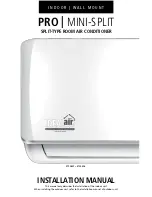
175244-BIM-A-0706
Unitary Products Group
63
cal connection. Check to make sure that the
ceramic insulator on the pilot ignitors or sensors is
not broken or cracked, if all are intact, replace the
ignition control IC1 or IC2.
The draft motor runs and the ignitor sparks at the pilot
burner but the pilot does not ignite and a gas odor is
not detected at the draft motor outlet.
1.
Check to make sure gas is being supplied to the
unit. Make sure that the gas pressure to the unit is
within the proper limits as described in the “POST
START CHECK LIST” page 54 and that the pilot
adjust screw is allowing some flow of gas as
described in “PILOT CHECKOUT” page 55.
2.
Check all wiring between the ignitor control and the
gas valve. Check to make sure the ground connec-
tions are intact.
3.
If the wiring is intact, check for 24 volts across ter-
minals “PV” and “COMMON” on the ignitor control.
If 24 volts is not present, replace the ignitor control.
4.
If 24 volts is present, remove the pilot burner and
remove the pilot orifice from the pilot burner. The
orifice is removed in the direction opposite the flow
of gas. Inspect the orifice for obstruction. If it is
clear, replace the main gas valve.
The ignitor sparks at the pilot burner but the pilot does
not ignite and a gas odor is detected at the draft motor
outlet.
1.
Adjust the pilot adjust screw on the gas valve as
described in “PILOT CHECKOUT” page 55.
2.
Check the supply pressure as described in “POST
START CHECK LIST” page 54. Make adjustments
as necessary.
3.
Check the pilot orifice for obstruction as described
in paragraph above. Clean as needed but the prob-
lem should not be the gas valve.
The pilot burner ignites but the ignitor continues to
spark and the main burners do not ignite.
1.
Make the same checks and adjustment as
described in “PILOT CHECKOUT” page 55.
2.
Check the supply pressure as described in “POST
START CHECK LIST” page 54. Make adjustments
as necessary.
3.
Make sure that the pilot burner is not bent or dam-
aged.
4.
Make sure that the ground connections at the pilot
burner, gas valve and ignitor control are intact.
Check the high tension wire for good electrical con-
nection. If all are intact, replace the ignitor module.
The pilot burner lights and the spark stops but the main
burners do not light.
1.
Check electrical connections between the ignitor
control and the gas valve. If intact, check for 24
volts across terminals “MV” and “COMMON” termi-
nals. If no voltage detected, replace ignitor control.
If voltage is present, replace gas valve.
Furnace lights with roll-out or one burner has delayed
ignition.
1.
Make sure that the pilot burner is aligned properly
with the carryover as described in “PILOT CHECK-
OUT” page 55.
2.
Make sure that the carryovers on adjoining burners
are screwed fast and are level with respect to one
another.
Main burners light but exhibit erratic flame characteris-
tics.
1.
Adjust air shutters as described in “BURNER AIR
SHUTTER ADJUSTMENT” page 55.
2.
Check the main burner orifices for obstruction and
alignment. Removal procedure is described in
BURNER INSTRUCTIONS page 55. Clean or
replace burner orifices and burners as needed.
UNIT FLASH CODES
Various flash codes are utilized by the unit control
board (UCB) to aid in troubleshooting. Flash codes are
distinguished by the short on and off cycle used
(approximately 200ms on and 200ms off). To show
normal operation, the control board flashes a 1 second
on, 1 second off "heartbeat" during normal operation.
This is to verify that the UCB is functioning correctly.
Do not confuse this with an error flash code. To prevent
confusion, a 1-flash, flash code is not used.
Alarm condition codes are flashed on the UCB lower
left Red LED, See Figure 27. While the alarm code is
being flashed, it will also be shown by the other LEDs:
lit continuously while the alarm is being flashed. The
total of the continuously lit LEDs equates to the number






































